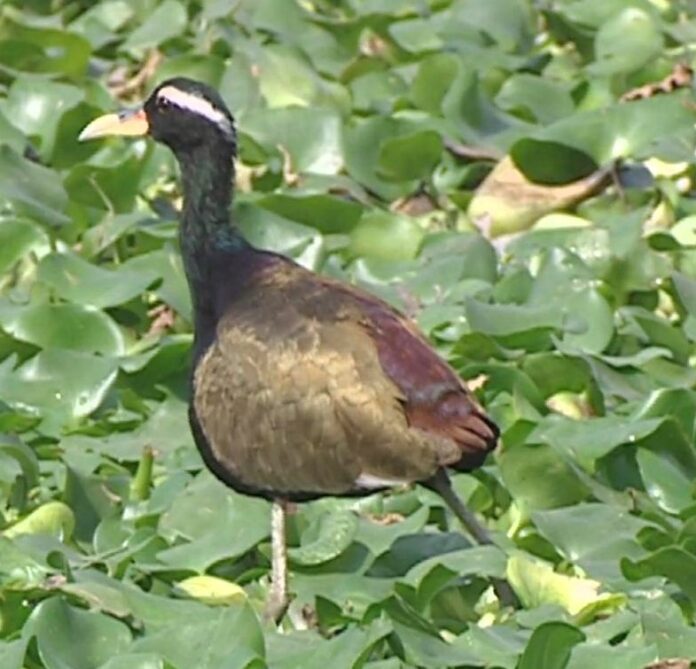Bronze Winged Jacana. Metopidius indicus (Latham)
Bronze Winged Jacana, is a swamp bird, about the size of a partridge having a wing span of about 54 cms.
The Length may vary from 28-31 cms. Both sexes are alike but the female, with a weight of 226-355 gms., is about 60% larger than the male which could weigh from 147-202 gms. The adults are endowed with glossy black plumage in the head, neck and breast region and a metallic greenish bronze back and wings. A broad white stripe extends from the eye to nape. The legs are very long and spider like. The widely spreading toes enable it to walk on floating and emergent vegetation, which it generally inhabits, by distributing the birds weight.
The bill has a yellow tip and red base and a frontal bluish shield which becomes bright red during courtship.
This clip shows an adult non breeding bird and a juvenile. The juvenile is chiefly whitish, rufous and brown.
The species is widely distributed in India, Sout East Asia to South China, South Sumatra and West Java. It is present throughout the year in South East Pakistan (Sind). Salim Ali reports an absence from Sri Lanka. A dweller of swamps, tanks, ponds it may also be found in denser vegetation, wet grasslands and over grown paddy fields.
Reported as primarily vegetarian, it can also feed on insects, snails and other invertebrates.
Nesting season is generally from June to September. The species is polyandrous with females generally mating with 1 to 4 different males in a season. Larger females secure more mates and produce more clutches.
The clutch size ranges from 3 to 4 eggs (3 to 4 cms. each), glossy bronze brown with an irregular network of blackish scrawls.
The nest is built of aquatic vegetation and may be only 15-20 cm wide. The interclutch gap in females may be 10 to 36 days with an incubation period of 26-27 days. The male alone incubates the egg and cares for the clutch by defending them aggressively. Males generally restricted to raising one brood during the breeding season as they become sexually in active for two months after mating. A considerable number of clutches are predated before hatching by rodents and other birds.
It is not a globally threatened species and is defined as a species of least concern by the IUCN.
©Srimaa Communication
Acknowledgements-Dr. Yashpal Singh, Mrs. Neena Singh, Manoj Kumar Yadav
